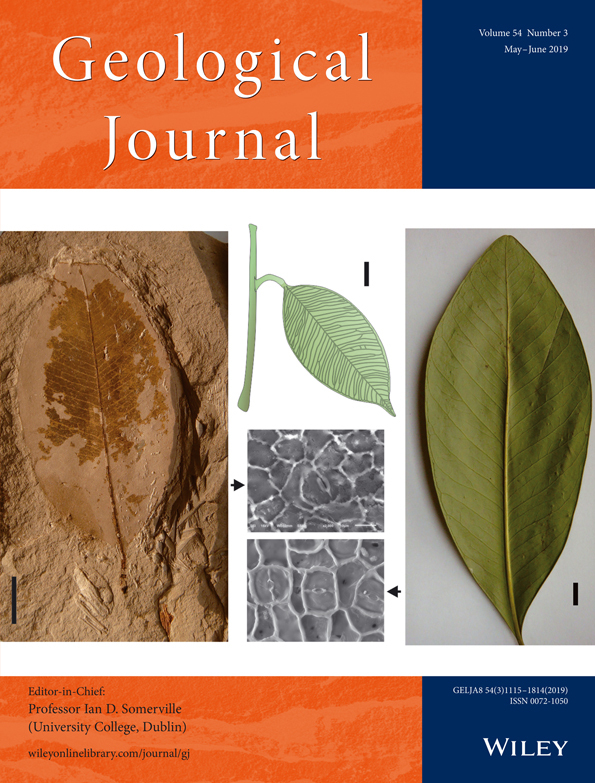Sequence stratigraphy and facies architecture of a mound-shoal-dominated dolomite reservoir in the late Ediacaran Dengying Formation, central Sichuan Basin, SW China
Abstract
The late Ediacaran Dengying Formation is one of the oldest carbonate microbial mound and shoal reservoirs in the world. This formation has recently attained widespread attention with the significant discovery of a huge volume of natural gas in the central part of the Sichuan Basin, South China. To fully understand the depositional processes and impacts on the reservoir, a comprehensive study of the sequence stratigraphy and facies architecture as well as reservoir analysis was undertaken by integrating analysis of seismic, well-logging, and core data. The D4 member consists of nine types of lithofacies representing distinguished depositional environments. These types of lithofacies can be grouped into five types of lithofacies associations, which are platform-margin shoal, mound-shoal complex, microbial mound, lagoon, and tidal flat. The platform margin was dominated by shoal and mound-shoal complexes, whereas the platform interior contained microbial mounds, lagoon, and tidal flat facies. We constructed a high-frequency sequence stratigraphy framework and identified two third-order sequences (SQ1 and SQ2) in the Dengying Formation and five fourth-order sequences (SQ2-1 to SQ2-5) in the fourth member of the Dengying Formation (the D4 member). In the D4 member, the thickness of the mound-shoal complex increases from the bottom to the top. The reservoir spaces in this Formation generally have low porosity and low permeability and include dissolution vugs and caves, and intercrystalline vugs and pores. Three types of reservoirs are identified, which are early-stage karst mound-shoal reservoirs, late-stage karst superimposed reservoirs, and other factors impacted reservoirs. Microbial mound and shoal facies are the material basis for a favourable reservoir, with the key factor for the improvement of reservoir quality being early-stage meteoric-water dissolution related to fourth-order sequence boundaries. The tectonic unconformity that was formed at the end of the Sinian Stage dominates the development and distribution of the most beneficial reservoir beds. Organic acid, hydrothermal fluid, and tectonic fracturing processes modified the reservoir beds in advance. Results from our investigation enable us to propose a model for the depositional evolution and reservoir formation in the D4 member of the Dengying Formation.
1 INTRODUCTION
Carbonate microbial mound consists of important oil and gas reservoirs in many oil and gas fields throughout the world, for example, the Ediacaran–Cambrian Ara Group in the Sultanate of Oman (Grotzinger & Al-Rawahi, 2014), the Ediacaran and Cambrian in East Siberia (P. Luo, Wang, et al., 2013), the Carboniferous of the Tengiz Field in the Precaspian Basin of Kazakhstan (Collins et al., 2014), and the Upper Jurassic in Little Cedar Creek field of the USA (Al Haddad & Mancini, 2013). Carbonate microbial mounds have become the main hydrocarbon exploration target in the petroliferous basins in China, for example, the Cambrian Xiaoerbulake Formation in the Tarim Basin (J. Song et al., 2014), the Middle Proterozoic Wumishan Formation in the Renqiu Oilfield (Mei, Gao, Meng, & Liu, 2008), and the Ediacaran Dengying Formation in the Sichuan Basin (L. Li, Tan, et al., 2013; Liu et al., 2016). The sedimentary features (Berra, Balini, Levera, Nicora, & Salamati, 2012; Della Porta, Bahamonde, Kenter, & Verwer, 2017; Della Porta, Kenter, Bahamonde, Immenhauser, & Villa, 2003; Hips, Haas, Poros, Kele, & Budai, 2015; Warusavitharana & Parcell, 2013) and reservoir characteristics (Lipinski, Franseen, & Goldstein, 2013; Słowakiewicz, Tucker, Pancost, Perri, & Mawson, 2013; Wahlman, Orchard, & Buijs, 2013) of microbial mounds were extensively studied in order to better clarify the controls on high-quality reservoir property. Despite the extensive studies on sedimentary features and reservoir characteristics, however, no consensus has been reached on the distribution and controlling factors of reservoirs formed in microbial mounds (Al Haddad & Mancini, 2013; Goldstein, Franseen, & Lipinski, 2013; Sarg, Suriamin, TÌnavsuu-Milkeviciene, & Humphrey, 2013). Facies analysis in a sequence stratigraphic framework is the key to reveal the distribution of the microbial mound reservoir, which develops largely on depositional facies.
The Ediacaran (known as the Sinian in China) is widely distributed in south China and includes the Doushantuo Formation (635~551 Ma) and the Dengying Formation (551~541 Ma; Bowring et al., 2007; Y. L. Chen, Chu, Zhang, & Zhai, 2015; Condon et al., 2005; S. Zhang et al., 2005). The Ediacaran in China has been of scientific interest for more than a century with numerous paleontological (McFadden, Xiao, Zhou, & Kowalewski, 2009; Xiao et al., 2014; Yin et al., 2013; Yuan, Chen, Xiao, Zhou, & Hua, 2011), paleogeographical, paleoclimatological, and paleoecological investigations being undertaken (Hohl et al., 2015; Jiang, Shi, Zhang, Wang, & Xiao, 2011; D. Li et al., 2009; D. Li, Ling, et al., 2013; Ling et al., 2013; Tahata et al., 2013; Wang, Shi, Jiang, & Tang, 2014). The dolomite of the Dengying Formation has long been studied by petroleum geologists for it is one of the most important gas-producing reservoirs in the Sichuan Basin (Figures 1 and 2). Natural gas in this formation has been explored for more than half a century since the discovery of the Weiyuan gas field in the Leshan-Longnvsi Uplift area of the Sichuan Basin in 1964 (W. H. Song, 1996; J. Zhang & Zhang, 2002). However, no significant breakthrough was made until 2011 when well GS1 in the Gaoshiti-Moxi tectonic belt in the central part of the Sichuan Basin produce high-yield industrial gas flow (more than 1,020,000 m3/day; Wei, Du, et al., 2015; Zou et al., 2014). The geological natural gas reserves of the Sinian and the Cambrian amount to more than 1 trillion m3. The gas field of the Dengying Formation in the Gaoshiti-Moxi tectonic belt (central Sichuan Basin) is one of the largest Pre-Cambrian gas fields in the world (Zhu et al., 2015; Zou et al., 2014); researches of the Dengying Formation have therefore intensified.
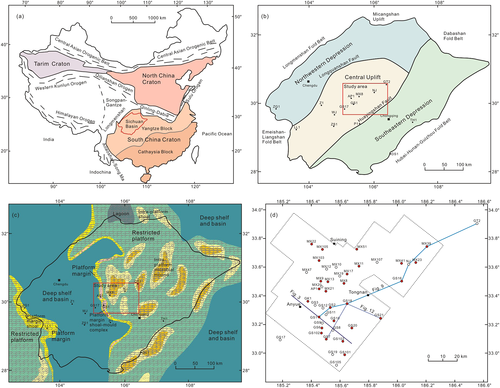
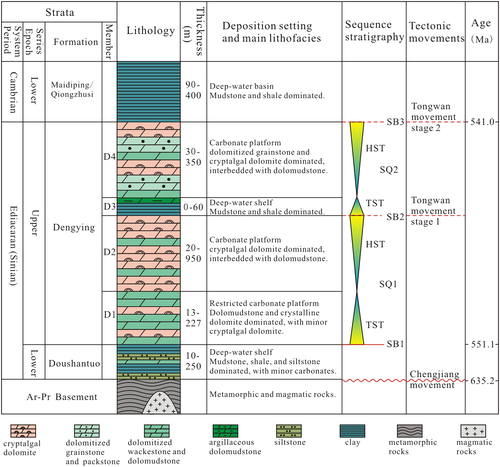
The reservoirs of the Dengying Formation in the central Sichuan Basin are mainly developed in the carbonate microbial-mound and shoal facies that were further improved by karstification (Wei, Du, et al., 2015; Zou et al., 2014). In the central part of the Sichuan Basin, the depositional environment has been shown to be a shallow marine with a warm climate during the late Ediacaran period (B.W. Luo, Wei, Yang, & Dong, 2013), and the main sedimentary facies include a north-to-south-striking platform margin belt and a restricted platform in the east (Figure 1c; J. Zhang & Zhang, 2002; Zou et al., 2014). The Dengying Formation is predominantly composed of cryptalgal dolomites, dolomitized grainstones, and crystalline dolomites (Si, Hao, Zhou, Ni, & Pan, 2014; W. Yang, Wei, et al., 2014; Yao et al., 2014) and can be divided into two seismic sequences that are separated by an intraformational unconformity (Zhong et al., 2013). Most reservoirs in the Dengying Formation have low porosity and low permeability. High-quality reservoirs are primarily controlled by sedimentary facies, karstification, and other diagenetic events. However, in the central part of the Sichuan Basin, high-resolution sequence stratigraphy, facies distribution in a sequence framework and the origin of favourable reservoirs of the Dengying Formation are yet to be determined.
By using cores, thin sections, well-logs, and seismic data from the Dengying Formation in the central part of the Sichuan Basin, we aim to (a) define high-frequency sequence stratigraphic framework to reveal the distribution of sedimentary facies and (b) determine the characteristics and the controlling factors of the reservoirs. Our results will not only improve the understanding of the depositional evolution of the Upper Ediacaran, they will also be of great significance for natural gas exploration in the central part of the Sichuan Basin.
2 GEOLOGICAL SETTING
The Sichuan Basin located in south-western China has a rhombic shape with a surface area of about 188,000 km2 (Figure 1a). The basin is tectonically located at the northern part of the South China Craton and western part of the Yangtze Block (Figure 1a; G. Zhao & Cawood, 2012). It is bounded by the Longmenshan Fold Belt, the Micangshan Uplift, the Dabashan Fold Belt, the Hubei-Hunan-Guizhou Fold Belt, and the Emeishan-Liangshan Fold Belt (Ma et al., 2007; Zhong et al., 2013). The Sichuan Basin has the largest volume of exploited natural gas reserves, the highest number of explored natural gas fields and the huge volume of natural gas production in China (Dai, Xia, Wei, & Tao, 2001; Z. J. Jin, 2011). Long-term tectonic evolution in the basin since the Palaeozoic has resulted in the formation of several tectonic units including the Central Uplift, the Northwestern Depression, and the Southeastern Depression (Figure 1b). From the Sinian to the Middle Triassic, the Sichuan Basin was a cratonic basin and an intracraton rift which developed through the late Palaeozoic to the Middle Triassic. From the Late Triassic to the Cenozoic, the basin changed to a foreland basin that was filled by substantial marine deposits interbedded with terrestrial deposits (Deng, 1992; Wei et al., 2005). The distribution and accumulation of gas reserves in the Sinian and the lower Palaeozoic was controlled by the tectonic evolution of the Leshan-Longnusi Uplift, which is located in the west and central parts of the Sichuan Basin. Recent investigations (Wei, Yang, Du, Xu, Zou, Xie, Wu, et al., 2015; Wei, Yang, Du, Xu, Zou, Xie, Zeng, et al., 2015; Zou et al., 2014) indicates that the basin underwent extensional tectonic setting during the Sinian. Influenced by the movement of the basement faults, a north-to-south-striking rift was formed in the centre of the cratonic basin, which is adjacent to the Gaoshiti-Moxi Uplift in the east. Controlled by this structural pattern during the late Sinian, the oldest carbonate rimmed platform in China was formed in the Sichuan Basin (Figure 1c). This carbonate platform experienced uplift due to the Tongwan movements and was exposed at the middle and last stage of the late Sinian (Figure 2). The Dengying Formation therefore underwent substantial erosion and corrosion during this period (W. Li, Liu, Deng, Zhang, & Zhou, 2015; B. Luo, Yang, et al., 2015; Xing, Hou, Lin, Xu, & Hu, 2015; Zhu et al., 2014). The study area is located in the Gaoshiti-Moxi Uplift in the central part of the Sichuan Basin (Figure 1d), and it is the most important natural gas producing region of the Sinian and Cambrian.
The Upper Sinian Dengying Formation (Figure 2) with a thickness of about 600–1,000 m is widely distributed in and around the Sichuan Basin (J. Zhang et al., 2014). It is conformably underlaid by the Doushantuo Formation and unconformably overlaid by the Lower Cambrian Qiongzhusi Formation. The Dengying Formation can be divided into four members from the bottom to the top (Figure 2): (a) The D1 member is mainly composed of micritic dolomite and fine-crystalline dolomite with few cyanobacteria and algae fossils. (b) The D2 member is dominated by algal dolomites with conspicuous karst breccia at the top. A grape-lacy structure and dissolution vugs are common in this member which is unconformably overlaid by the D3 member. (c) The D3 member is dominated by shale and thin-bedded argillaceous dolomite. (d) The D4 member is predominantly characterized by cryptalgal dolomite, dolomitized grainstones, crystalline dolomites and occasionally occurring striped silica. Karst breccia dolomites are common at the top of this member (Yao et al., 2014; J. Zhang et al., 2014).
3 MATERIALS AND METHODS
Our study is based on data from 25 wells in the central part of the Sichuan Basin (Figure 1d). The well-logging data include natural gamma ray logs, gamma-ray spectra logs, resistivity logs, and acoustic logs. Detailed observations and descriptions were made from 456 m cores and 100 thin sections (25 of which are casted) from nine wells. We also describe and interpret a c.1,520 m formation micro-scanner (FMI) image from seven wells.
The study of lithofacies and sedimentary facies were mainly based on cores and thin sections. The classification of rock type was in accordance with Dunham (1962). The colour, texture, composition, major fossils, sedimentary structure, and diagenesis characteristics were described, and their implications for deposition environments and diagenetic backgrounds were interpreted. The facies of the wells without cores were interpreted by analysing the logging curves and FMI images.
3-D seismic profiles with calibration of well-logging data were used to identify the third-order sequence boundaries of the Dengying Formation. Fourth-order sequence boundaries were identified using the characteristics of the sedimentary successions revealed by continuous cores, natural gamma ray logs (GR), potassium and thorium logs (KTh), and FMI images. On the basis of facies analysis and sequence stratigraphy with individual well profiles, the facies distribution within the sequence stratigraphic framework was analysed.
The analysis of reservoir was mainly based on the cores and thin sections. The classification of pore spaces is referred to Choquette and Pray (1970) and Lucia (1995). Detailed descriptions of pore types, size, connectivity and visual porosity in the cores and thin sections were undertaken. Combining this analysis with sequence stratigraphy and sedimentary facies enabled the classification of reservoirs to be proposed. By using FMI images, reservoir types in individual wells were interpreted and the distribution of different types of reservoirs within the sequence stratigraphic framework was also analysed.
4 FACIES ANALYSIS
4.1 Lithofacies
Based on core and thin section analysis, nine lithofacies have been identified in the D4 member of the Dengying Formation. Based on the different sedimentary characteristics of the lithofacies, depositional environments associated with each lithofacies can be interpreted. Photographs of the cores and thin sections are shown in Figures 3 and 4, and Table 1 summarizes the characteristics of each lithofacies.
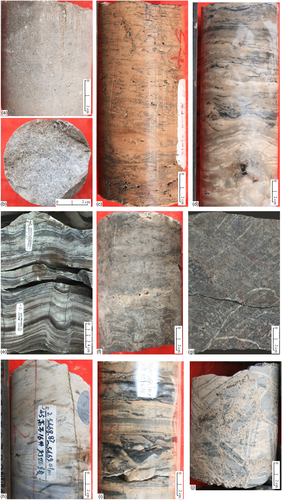
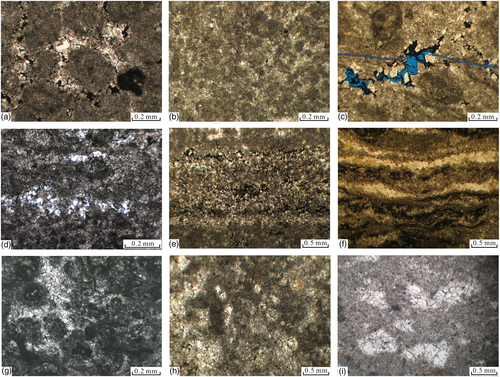
| Lithofacies code | Lithofacies | Description | Interpretation | Reservoir quality | Reservoir space |
|---|---|---|---|---|---|
| F1 | Dolomitized grainstone | Light grey colour, thick-bedded or massive structure, low-angle cross-bedding. Grains are mainly well-sorted, sand-size, round, and dark-colour intraclasts. | Platform margin, shoal facies, high energy | Good | Intergranular dissolution vugs and small caves |
| F2 | Dolomitized packstone and grainstone with algae | Brownish grey to grey colour, medium- to thin-bedded. The components are predominantly silt- to sand-size intraclasts and peloids and minor filaments of bacteria and algae. | Platform margin and intraplatform, shoal facies, moderate energy | Good | Intergranular dissolution vugs and pores related to laminae |
| F3 | Algal-rich dolomitized wackestone | Grey colour, medium- to thin-bedded. A small proportion of peloids and rich algae content (30~50%) forming semi-continuous and wavy laminae and/or cluster structures. | Platform margin, microbial mound facies, moderate energy | Moderate | Pores related to laminae |
| F4 | Stromatolite | Greyish brown to dark grey colour, dense and continuous wavy, hummocky or flower-shaped laminae. Siliceous content is common to fill between the laminations and to replace the dolomite crystals. | Restricted marine platform, microbial mound facies, low to moderate energy | Poor | A few dissolution vugs |
| F5 | Thrombolite | Grey to dark grey in colour, dark microbial-rich crumbs or clots developing between micritic and silt-sized crystalline dolomites. | Restricted marine platform, microbial mound facies, moderate energy | Poor | A few dissolution vugs |
| F6 | Thin-bedded micritic dolomite | Brown to grey colour, thin-bedded, teepee and birds-eye structures, usually less than 1 m thick. | Restricted marine platform, tidal flat, low energy | None | Very few pores |
| F7 | Argillaceous micritic dolomite | Dark grey to black colour, thin- to medium-bedded, containing argillaceous stripes and soft-sediment deformation structure. | Restricted marine platform, lagoon, low energy | None | Very few pores |
| F8 | Karst breccia dolomite | Brown colour, tightly compacted gravels, generally located at the top of a shallowing-upward sequence, usually less than 1 m thick. | Early-stage dissolution related to high-frequency sequence stratigraphic boundaries | Poor | A few residual pores |
| F9 | Cave-filling breccia | Mainly composed of centimetre-size angular-shaped gravels, intergravel space is usually filled with mud matrix or crystalline dolomites, located at the top boundary of the D4 member. | Collapse sediments in caves which were formed by late-stage karstification | Poor | A few residual intergravel pores and fractures |
4.1.1 Dolomitized grainstone (F1)
Dolomitized grainstone is usually light grey to brownish grey in colour (Figures 3a,b and 4a) with thick-bedded or a massive structure. Grains are mostly well-sorted, rounded, and sand-sized intraclasts (0.1–0.3 mm) with a large proportion showing a dark colour as they contain organic material. Subhedral dolomite crystals are shown in the intergranular space. Low-angle cross-bedding can be observed on the cores indicating high-level energy during deposition. As the main lithofacies in shoal, dolomitized grainstones mainly developed on the platform margin and have good reservoir properties. Acicular-shaped dissolved pores and holes are densely developed in the cores.
4.1.2 Dolomitized packstone and grainstone with algae (F2)
Dolomitized packstone and grainstone with algae are generally brownish grey to grey in colour (Figures 3c and 4b,c) with a medium- to thin-bedded structure. The main components of this lithofacies are predominantly silt- to sand-size intraclasts and peloids (0.05–0.15 mm) which show unclear outlines and subrounded to rounded shapes. Some thread-like filaments of bacteria and algae forming dark discontinuous laminae are displayed both in the cores and in the thin sections. F2 was formed under a moderate-energy depositional environment, and it comprises the main lithofacies of the shoal facies. The occurrence of algae material in this lithofacies indicates that they were deposited near microbial mounds. The size of grains in this lithofacies are much smaller than that in the F1, representing a decrease of wave energy that may have been caused by an increase in microbial binding process. The lithofacies has good reservoir properties and dissolved pores are the main reservoir spaces.
4.1.3 Algal-rich dolomitized wackestone (F3)
This lithofacies is characterized by a rich algae content forming semi-continuous and wavy laminae and/or cluster structures (Figure 3d). A small proportion of silt-size grains, including peloids can be seen in the thin sections (Figure 4d). F3 are regularly interbedded with F2 in vertical profiles. The algal bloom in this lithofacies indicates a moderate- to low-energy shallow marine, oxygen rich environment (photic conditions) with abundant nutrients. This lithofacies has moderate porosity, and most of the pores are associated with algal-rich laminae.
4.1.4 Stromatolite (F4)
This lithofacies is mainly greyish brown to dark grey in colour, characterized by dense and conspicuous continuous wavy, hummocky, or flower-shaped laminae in the cores (Figure 3e,f). Thin section analysis showed alternating bright and dark laminations. The bright laminae are mainly composed of silt-size crystalline dolomites and minor peloids while the dark laminae contain mainly mud dolomites with abundant bacteria and algae contents (Figure 4e–f). Siliceous materials are commonly seen between the laminations and replace the dolomite crystals. F4 is generated under low to moderate water energy in a restricted-marine depositional environment, and it is the main type of lithofacies forming microbial mounds on the platform. The porosity of stromatolitic dolomite is low due to poorly developed dissolved pores.
4.1.5 Thrombolite (F5)
Thrombolitic dolomite is predominantly grey to dark grey in colour (Figures 3g and 4g,h) and it is characterized by dark microbial-rich crumbs or clots, which develop between light-grey micritic and silt-sized crystalline dolomites. Most of the dark crumbs or clots have clear outlines and irregular elongated shapes with lengths ranging from 2 to 20 mm (Figure 3g). Thrombolite lithofacies are usually vertically interbedded with F4, F3, and F2. The various sizes of clots indicate a moderate-energy depositional environment with good water-circulation suitable for the reproduction of cyanobacteria and algae. Thrombolites represent the main lithofacies forming the microbial mounds and mound-shoal complex. A small proportion of dissolution vugs can be seen in the cores and thin sections of this lithofacies.
4.1.6 Thin-bedded micritic dolomite (F6)
This lithofacies is typically brown to grey in colour and about 0.2–0.5 m thick. Birds-eye structures and teepee structures are common (Figure 4h,i). This lithofacies is interpreted to be a product of intertidal or supratidal deposition in the platform interior under low-energy conditions. The birds-eye pores and other dissolved pores are mainly filled with dolomite cement (Figure 4i).
4.1.7 Argillaceous micritic dolomite (F7)
This lithofacies (Figure 8b,c) is characterized by a dark grey to black colour that makes it easily distinguished from other lithofacies. This is the main type of lithofacies associated with restricted lagoon, indicating a relatively reductive depositional environment. Most samples of this lithofacies have very low porosity.
4.1.8 Karst breccia dolomite (F8)
Karst breccia dolomite lithofacies are mainly brown in colour (Figures 3i and 8d) and are located at the top of a shallowing-upward sequence. The thickness of this lithofacies is usually less than 1 m. Most breccia clasts display angular to subangular shapes and are tightly packed and infilled with clay and dolomite mud (Figure 3i). These features indicate that the lithofacies was formed by short-term subaerial exposure. Only a few residual pores can be seen in the cores.
4.1.9 Cave-filling breccia (F9)
This lithofacies (Figure 3j) is mainly composed of mixed size angular-shaped clasts and it has a sharp boundary with the lower parts of the unkarsted strata. This lithofacies often appears at the top 20 m part in the D4 member. It resulted from the collapse of caves which were formed by prolonged subaerial karstification. The pores between the gravels are usually filled with mud matrix and dolomite cement resulting in low porosity.
4.2 Lithofacies associations
Based on seismic, logging, and core analysis, the depositional environment in the study area can be divided into a platform margin and a restricted platform. Five types of lithofacies associations can be defined: platform-margin shoal, mound-shoal complex, intraplatform microbial mound, intraplatform shoal, lagoon, and tidal flat.
4.2.1 Platform-margin shoal
Platform-margin shoal (Figure 5a) is dominated by dolomitized grainstones (F1), dolomitized packstones and grainstones with algae (F2), and algal-rich dolomitized wackestones (F3), usually forming a vertical, ~10-m-thick depositional succession. The lower part of the succession is mainly composed of F2 and F3 forming multiple small-scale cycles. Towards the upper part of the depositional succession, the small-scale cycles become thicker and the content of F1 increases, and cross-bedding can be seen in F1. The lithofacies at the top of the succession transformed to thin-bedded micritic dolomite (F6). The lithofacies association of this facies indicates that the hydrodynamic condition of the depositional environment increased towards the top of the succession, which was beneficial to the growth of carbonate sand shoal. The thickness of the small-scale cycles and the carbonate grain contents increase from the bottom to the top of this facies, indicating the progradation of sand shoals and a fall in relative sea level. Shallowing-upward led to facies transition into tidal flat condition. The GR and KTh well-logging curves platform-margin shoal have funnel or box-like shapes with relatively smooth edges and very low values, usually less than 20 API for GR and less than 10 API for KTh (Figures 6, 7, and 9).
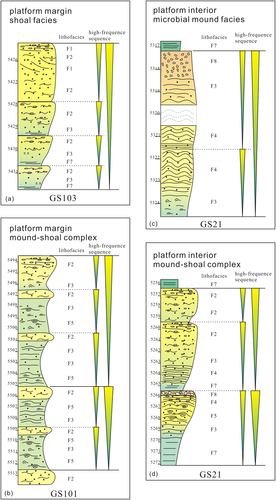
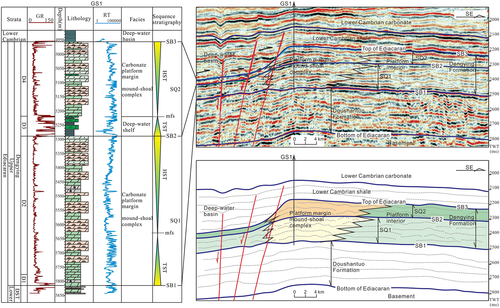

4.2.2 Mound-shoal complex
The mound-shoal complex is mainly composed of thrombolites (F4) associated with dolomitized packstones and grainstones with algae (F2), algal-rich dolomitized wackestones (F3), and stromatolites (F5; Figure 5b,d). This complex is characterized by widely developed cyanobacteria and algae, and the development of sand shoals and microbial mounds. The GR and KTh curves associated with mound-shoal complex has funnel-like shapes than those of platform-margin shoal because they have relatively jagged edges and wider ranges of values, usually 10–40 API for GR and 5–20 API for KTh (Figures 6, 7, and 9). In seismic profiles, platform-margin shoal and mound shoal complex are characterized by subparallel, wavy and strong reflection (Figure 6). This facies association often developed at the top of F2, and two subtypes can be distinguished from the vertical profiles.
Subtype-1 is characterized by thick F3 and F5 (2–5 m) interbedded with minor F2 (<1 m). F2 regularly developed in the top of the small-scale cycles and the thickness of F2 increased from the lower cycles to the uppermost cycle. This subtype of mound-shoal complex was deposited on the platform margin under a moderate energy condition, and it is usually accompanied by platform-margin shoals.
Subtype-2 mainly includes lithofacies F2, F3, F4, and F7. The lower part of each small cycle is mainly composed of F4 and F7, which are typical deposits of low-energy restricted platform. The upper part of each cycle is dominated by F2, representing a moderate-energy intraplatform environment. In some cycles, karst breccias (F8) develop at the topmost part of the cycles, indicating short-term subaerial exposure induced by a fall in relative sea level. This subtype of the mound-shoal complex is interpreted to be deposited in the platform interior.
4.2.3 Microbial mound
The microbial mound (Figure 5c) is dominated by thick-succession F4 which have dense wave-like or horizontal laminae. The lithofacies in this sequence often change to a brown-coloured breccia (F8) towards the top. In the GR and KTh curves, microbial mounds have higher values than shoals (20–40 API for GR and 10–20 API for KTh) and show moderately jagged curve edges (Figures 6, 7, and 9). They show small convex-shaped, moderate continuous reflections on seismic profiles (Figure 6). This succession indicates that the depositional setting was initially a predominantly shallow intertidal environment developed in the platform interior that was rich in microbes before changing to supratidal conditions. Short-term exposure caused by a fall in relative sea level resulted in breccia beds (F8) just below the sequence boundaries.
4.2.4 Lagoon
The lithofacies of lagoons is mostly composed of laminated argillaceous dolomites (F7) and minor light-grey micritic dolomites (F6), which developed in the uppermost part of the cycles. The GR and KTh values of this facies association are highest among the five types of facies associations, ranging from 40 to 80 API for GR and 20 to 50 API for KTh (Figures 6, 7, and 9). On seismic profiles, lagoon deposits are represented by reflections of weak amplitude, moderate to high continuity, and parallel layers (Figure 6). This lithofacies association indicates that the sedimentary environment was initially dominated by a restricted and a reductive aquatic environment before its deposition environment changed to a restricted tidal flat environment. The lagoon facies is an indicator of small-scale transgression occurring at the early stage of a relative sea-level rise.
4.2.5 Tidal flat
The lithofacies association of tidal flats is dominated by light-grey to brown-grey coloured laminated dolomicrite (F6). This facies is usually interbedded with lagoon facies in the platform interior, and it shows similar well-logging and seismic features with the lagoon facies (Figures 6 and 7). This facies has well-developed birds-eye structures and teepee structures, indicating a restricted shallow-marine environment with high levels of evaporation.
5 SEQUENCE STRATIGRAPHY
5.1 Third-order sequences
Based on the interpretation of seismic profiles tied with wells, we identified two third-order sequences in the Dengying Formation. These sequence boundaries were not only clearly identified on seismic profiles; they were also identified in the logging curves (Figure 6).
5.1.1 Sequence 1
Sequence 1 (SQ1) includes the D1 and D2 members. The bottom boundary (SB1) of this sequence appeared as a bright reflection surface on seismic profiles and was easily traced throughout the basin. The boundary is also the contact surface between the lower and the upper Sinian. The Doushantuo Formation is dominated by deep-water clay and shale just below the boundary. Overlying this boundary is the D1 member which is mainly composed of shallow-water carbonate platform deposits. The thickness of SQ1 is much smaller in the depression while it notably increases towards the Gaoshiti-Moxi Uplift. This trend is more obvious in the highstand systems tract (HST) of the sequence. The top boundary (SB2) is a parallel unconformity which appears as a moderate-continuous reflection surface on seismic profiles which makes it easy to trace this boundary across the basin. Below this boundary, karstification is widely developed on the entire carbonate platform in the central part of the Sichuan Basin.
5.1.2 Sequence 2
Sequence 2 (SQ2) includes the D3 and D4 members. The lower part of this sequence (the D3 member) has high gamma ray values and low electrical resistivity values. The lithofacies are predominantly dark-coloured mudstone, shale, and dolomudstone. These characteristics indicate a deep-water shelf environment representing a transgressive systems tract (TST). The upper part of this sequence (the D4 member) is mainly composed of dolomitized grainstones, cryptalgal dolomite, microbial dolomite, and crystalline dolomites, indicating a shallow-water carbonate platform depositional environment. This section is interpreted as the HST of the sequence. The thickness of the stratigraphic sequence in SQ2 decreased towards the fault depression and increased towards the uplift. The top boundary (SB3) of this sequence is also the unconformity between the Sinian and the Cambrian. It is an angular unconformity in the western part of the basin which becomes a parallel unconformity in the central part of the basin. The upper part of SQ2, within a range of about 120 m is affected by karstification to different extents with the development of karst breccias at the top.
5.2 Sequence architecture in the D4 member
Most of the wells in the central part of the basin only have strata that have been drilled to about 100 m below the SB2 boundary. Analysis of well logging data, FMI image data, cores, and thin sections revealed five fourth-order sequences (SQ2-1 to SQ2-5) in the D4 member (Figures 7 and 8). Below these fourth-order sequence boundaries, shoals and microbial mounds facies are well preserved. The logging curves of GR and KTh show box-like shapes with low amplitude, and the FMI images show light-colour massive facies with dark spots. Above the fourth-order sequence boundaries, the deposition sharply changed into lagoonal and inter-shoal low-energy deposits. The GR and KTh values generally increase sharply, and the FMI images show grey to dark laminations. These characteristics indicate that relative sea level rapidly rises during the early stage of the fourth-order sequence and, as a result, the depositional environment changed to a deep-water platform during the TST. At the late stage of the fourth-order sequence the depositional environment gradually became shallow marine, indicating that the relative sea levels slowly rise or remained stable. Microbial mounds and shoal facies mainly developed in the HST of the fourth-order sequences. Due to a small-scale fall in relative sea level at the end of the HST, platform deposits were briefly exposed resulting in the development of early karst. Karst breccias less than 1 m thick can be seen in the cores just below the fourth-order sequence boundaries. Since the subaerial exposure was brief, lowstand systems tract deposits were not preserved on the platform. The thickness of the TST in the fourth-order sequences was thinner towards the top while that of the HST was generally thicker.
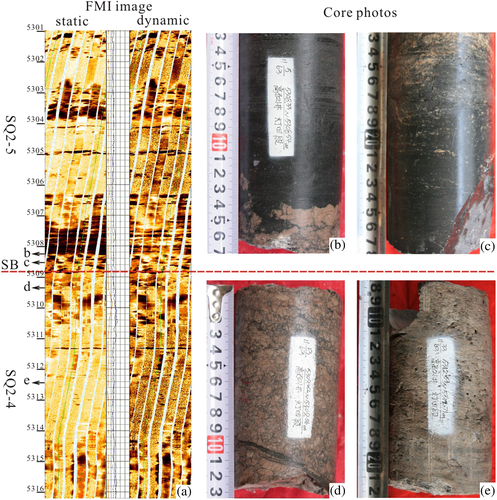
5.3 Facies distribution in sequence stratigraphic framework
Based on sedimentary facies interpretation from correlation of well-log cross-sections, the distribution of facies within the fourth-order sequence framework is analysed in the study area. The sequence boundaries of the Dengying Formation can be clearly recognized in the southeast-northwest section (Figure 9). The fourth-order sequence boundaries within the D4 member can be identified from the well-logging curves and the vertical successions.
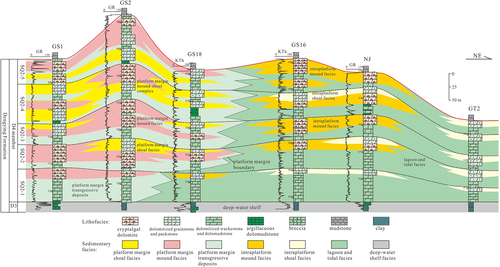
During the TST stage of SQ2 (D3 member), the deposits of the study area were typical deep-water shelf deposits dominated by dark-coloured clay, shale, and dolomudstone. The TST of SQ2 is widely distributed in the area with a thickness ranging from 30 to 50 m and is an important source rock. During the HST stage of SQ2 (D4 member), the depositional environment of the area changed to a carbonate platform and the platform margin was towards the west. Fourth-order sequences can be correlated between wells in the platform margin and platform interior, while the facies architecture in the sequence stratigraphy framework varies vertically and laterally. The vertical successions in the platform margin were dominated by shallowing-upward fourth-order sequences which were predominantly filled by platform-margin shoal facies and mound-shoal complex facies. The SQ2-1 is composed of thick transgressive deposits in the lower and middle parts with a minor microbial mound just below the top boundary. The platform is characterized by a gentle dipping slope to the shelf and basin, and shows little changes in thickness between the platform margin and the platform interior. During the SQ2-2, microbial mounds were the dominant deposits in the platform margin and formed a rise in the landscape. From SQ2-3 to SQ2-5, the mound-shoal complex continuously grew, resulting in a remarkable rise of the platform margin. The shallow part of the platform margin is dominated by thick and continuous secessions of mound-shoal deposits with thin and fewer intervals of transgressive deposits (GS2 in Figure 9), while the eastern flank, especially from SQ2-3 to SQ2-5 is characterized by alternating mound-shoal and transgressive deposits (GS18 in Figure 9). The fourth-order sequences of the HST of SQ2 in the platform interior were formed by (a) the lower transgressive part, which are mainly composed of lagoon facies, and (b) the upper regressive part, which are mainly composed of microbial mounds and tidal flat facies. The mound and shoal deposits in SQ2-1 in the platform interior were only developed below the top boundary of SQ2-1 (Figure 9, wells GS16, GT2, and NJ), and they noticeably increased in thickness in SQ2-2 and regularly developed in the upper part of SQ2-3, SQ2-4, and SQ2-5. From SQ2-3 to SQ2-5, the intraplatform mound and shoal in some wells are further divided into two or three cycles (GS16 in Figure 9).
6 RESERVOIR
6.1 Porosity and permeability
Porosity and permeability analyses of 225 samples showed that porosity ranged from 0.13% to 8.08% (average 2.41%), and permeability ranged from 0.001 to 663 mD (average 4.721 mD). This indicates that the reservoir of the D4 member has both low porosity and low permeability. The distribution of porosity and permeability is shown in Figure 10.
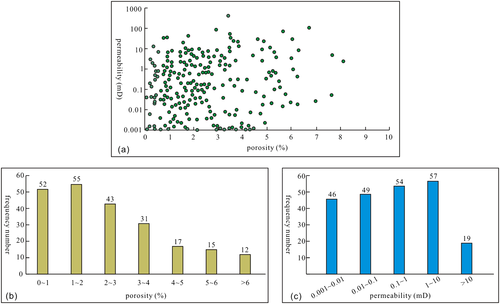
6.2 Pore types and characteristics
The types of reservoir space in the D4 member include caves, dissolution pores, and minor fractures (Figure 11) and are discussed below.
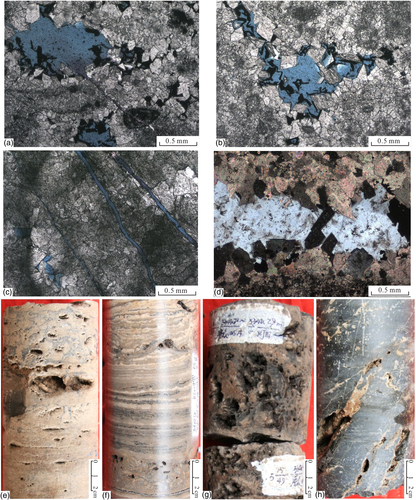
6.2.1 Karst caves
Karst caves are common in the examined cores (Figure 11e–h) and they range in size from 2 to 10 mm in diameter. A single cave is circular in shape and a group of caves have honeycomb appearance in the dolomitized grainstones. In laminated microbialite, a group of caves form enlarged dissolution stripes along the laminae. Small caves also occasionally occur along tectonic fractures. Although the caves are commonly filled with euhedral quartz and dolomite cement, a number of effective reservoir spaces are preserved.
6.2.2 Intercrystalline dissolution vugs and intercrystalline pores
Features with pore sizes ranging from 0.05 to 1.0 mm (Figure 11a,b) can generally be divided into intercrystalline dissolution vugs and intercrystalline pores. These types of pores are the most common reservoir spaces observed in the thin sections. Although some pores are partially or totally filled by siliceous material (Figure 11d), most of the effective reservoir spaces are preserved.
6.2.3 Fractures
Fractures in the D4 member include tectonic fractures and solution-enlarged fractures. In the cores, the tectonic fractures display high angles intersecting with the sedimentary beddings, contributing to the effective reservoir spaces and permeable paths. Dissolution fractures appeared as dark coloured network on the cores and they were generally filled with carbonaceous materials and bitumen. Solution-enlarged fractures observed in the thin sections generally have jagged shapes and curved edges. In these thin sections, the dissolution of matrix or grains and dark-colour undissolved clay were observed.
6.3 Reservoir types and characteristics
6.3.1 Early-stage karst mound-shoal reservoir (Type-I)
This type of reservoir is mainly developed in platform margin mound-shoal complexes and intraplatform mounds (Figures 3a–d and 11a,b). The reservoir space mainly included acicular dissolved pores, small vugs (2–5 mm diameter), and intercrystalline dissolved pores. Observation from thin sections and cores show that the distribution of pores and vugs were closely associated with laminations in the dolomitized grainstones and cryptalgal dolomites. High-quality reservoirs were predominantly located below the fourth-order sequence boundaries and in the upper part of the mound-shoal complex (Figure 12). The thickness of the Type-I reservoir is small in SQ2-1 and it increases from SQ2-2 to SQ2-4. Only one Type-I reservoir bed in mound and shoal facies was identified in SQ2-1, while in SQ2-2 and SQ2-3, two Type-I reservoir beds developed in the mound-shoal complex (Figure 12). These features indicate that the formation of the Type-I reservoirs was closely related to the primary sedimentary facies and the sequence boundary.
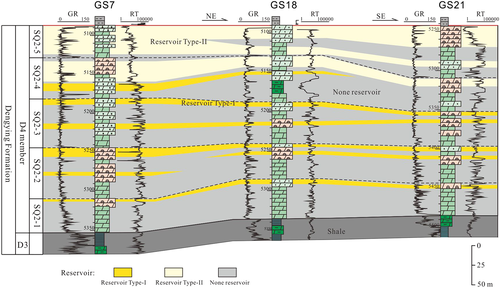
6.3.2 Late-stage karst superimposed reservoir (Type-II)
This type of reservoir is usually associated with karst breccia and predominantly occurs just below the unconformity SB3, located in the upper part of SQ2 (Figures 3j, 11d–f, 12). The reservoir space largely consists of honeycomb-like vugs and caves (5–30 mm diameter). Most high-porosity reservoirs developed in dolomitized grainstones and cryptalgal dolomites, and a small proportion of the high-porosity reservoirs developed in micritic dolomites and argillaceous dolomites. Compared with Type-I reservoirs, Type-II reservoirs have more conspicuous pores such as dissolved-enlarged vugs, small caves and fractures, and they have a large thickness and good connectivity. Although dense vugs and small caves can be seen in the deposits of lagoon and tidal flat facies, most reservoir spaces in Type-II beds show a close relationship with original beddings of mound and shoal facies in the uppermost part of the HST of SQ2 (SQ2-4 and SQ2-5). These features indicate that Type-II reservoirs are the result of late-stage karst superimposed on Type-I reservoirs.
6.3.3 Other factors impacted reservoir (Type-III)
The reservoir spaces in the Type-III reservoirs predominantly consist of tectonic fractures and solution-enlarged fractures (Figure 11h). Although Type-III reservoirs do not frequently occur in cores of the D4 member, fractures are found to be filled with hydrothermal minerals such as lead-zinc mineral and saddle dolomite. This shows that Type-III reservoirs are simultaneously modified by tectonic movements and deep hydrothermal fluids. The origin of Type-III reservoirs has no correlation with sedimentary facies and sequence boundaries, but is probably closely related with deep and large faults and associated fractures.
7 DISCUSSION
7.1 Controls on reservoir development
7.1.1 Sedimentary facies and fourth-order sequence boundaries
After the transgressive phase that deposited the D3 member (TST of SQ2), the central part of the Sichuan Basin was dominated by a carbonate platform which shows a shallowing-upward trend (HST of SQ2). The depositional dynamic features of SQ2 (D3 and D4 members) in the Sichuan Basin and the Shibantan and Baimatuo Members in the Yichang area are very similar (Duda et al., 2014; Duda, Zhu, & Reitner, 2016). The D4 member in the central Sichuan Basin consists of shoals and mound-shoal complex on the platform margin, and lagoon, tidal flat, and intraplatform mound-shoal complex in the platform interior. Reservoir analysis identifies that favourable reservoirs are mainly associated with mound-shoal complexes which have developed on both the platform margin and the restricted platform (Figure 12). These reservoirs are common in the dolomitized grainstones and cryptalgal dolomites and have high primary porosity. Shallow water and open water-circulation environments provided favourable conditions for the development of these facies, which occurred primarily in the upper parts of SQ2–1 to SQ2–5, especially in SQ2–3 to SQ2–5. The facies associations in the D4 member suggest that relative sea level frequently fluctuated during this period. As relative sea level fell during the late stage of the fourth-order sequences, these facies were prone to exposure and dissolution by meteoric water (Gao et al., 2014; Qu et al., 2013; Ronchi, Ortenzi, Borromeo, Claps, & Zempolich, 2010). Correlation of well-log cross sections (Figure 12) shows that the Type-I reservoir beds increased in thickness. The acicular pores and vugs in the dolomitized grainstones and dissolution vugs along the algal laminae suggest early karstification.
7.1.2 Unconformity and karstification
Unconformity and karstification are important factors for the development of carbonate reservoirs. The Tongwan movement that occurred at the end of the Sinian Stage in the Sichuan Basin resulted in significant uplift of the entire basin which caused the exposure of a large area from the west to the centre of the Sichuan Basin. Drilling data from the western parts of the Sichuan Basin identified the absence of SQ2 sequences in the Dengying Formation (D3 and D4 members), as well as the occurrence of a widespread karst breccia in the upper part of the D4 member of the Dengying Formation. On the basis of 2-D seismic profiles, the paleogeomorphological reconstruction of the Sichuan Basin shows that the centre of the Sichuan region was located on an east-inclined slope (B.W. Luo, Jia, et al., 2015; Y. Yang, Huang, et al., 2014). Previous investigations have shown the karst carbonate slope as the most favourable zone for the development of karst reservoirs (J. Chen et al., 2007; Hu, Fu, Cai, Yang, & Zhu, 2014; Z. K. Jin, Zou, Jiang, & You, 2001; Yan et al., 2005). The recognition of honeycomb-like vugs, caves, solution-enlarged fractures, and karst breccias in the cores, in conjunction with mud-loss and missing drill-bits during the drilling process, indicates that intense karstification occurred in the D4 member of the Dengying Formation at the end of the Sinian Stage. This kind of karstification was described by W. Z. Zhao et al. (2013) and Hu et al. (2014) as inter-strata karstification which is distinct from buried-hill karst and penecontemporaneous karst (early-stage karst). The intensity of inter-strata karstification is largely affected by the primary porosity of the rock (He, Gao, Zhang, Ding, & Jiao, 2014; Yu, Fan, Huang, Liu, & Gao, 2007). Therefore, in comparison with dolomudstones which have very low primary porosity, mound-shoal complexes have high primary porosity and constitute the best Type II reservoir beds in the D4 member. Drilling data show that these favourable reservoir beds were mainly distributed on mound-shoal deposits within 120 m below the unconformity at the top of the Dengying Formation (Figure 12).
7.1.3 Deep-burial dissolution and diagenesis
Burial karstification refers to the dissolution process caused by acid fluids within the deeply buried carbonate strata. These fluids include magmatic hydrothermal fluids, organic acid and H2S produced by thermochemical sulphate reduction processes (Hu, Cai, Hu, Qian, & Xiang, 2009). These widely circulated deep fluids can play an important role in the modification of the reservoirs. Previous investigations have shown that multi-phase movements of deep fluids in the Sichuan Basin have influenced the modification of the Dengying Formation (Huang et al., 2009; Liu et al., 2008; Zhu et al., 2015). The in-filling of pores by quartz, siliceous material replacing carbonate minerals, and lead-zinc deposits and saddle dolomites filling in the tectonic fractures can be interpreted as the result of deep hydrothermal fluids. From residual bitumen lining the inner margin of dissolution vugs and the spherical margin shape of the vugs, we inferred that the vugs were modified by organic acids.
7.2 Depositional evolution and reservoir development model
Based on a comprehensive study of sequence stratigraphy, sedimentary facies, reservoir characteristics and controls on favourable reservoirs, we propose a model for the depositional evolution and reservoir development of the D4 member of the Dengying Formation (Figure 13). During the early stage of the D4 member, only small-scale mound-shoal complexes developed in the transition zone between the carbonate platform and the intracratonic rift. As penecontemporaneous karstification was very localized (Figure 13a), the quality of the reservoir was poor to moderate. During the late stage of the D4 member, the rapid growth of mound and mound-shoal facies formed a minor-uplift within the platform margin belt and the intraplatform area. Controlled by the fourth-order sequence boundaries, these facies were generally dissolved and modified by penecontemporaneous karstification processes, which form dolomite breccia and dissolution vugs and caves that are closely related to the laminae in the dolomitized grainstones and algal dolomites (Figure 13b). After the deposition of the D4 member, most areas in the basin were uplifted during the second episode of the Tongwan tectonic movement. This uplift caused extensive exposure of the former carbonate platform which subsequently led to intense erosion and supergene karstification. The early-formed mound-shoal reservoir beds, vugs and caves were further dissolved by penetrating meteoric water, resulting in the formation of excellent supergene karst reservoirs (Figure 13c). During the burial stage of the D4 member, the reservoirs were further modified by deep hydrothermal fluids and organic acids (Figure 13d).
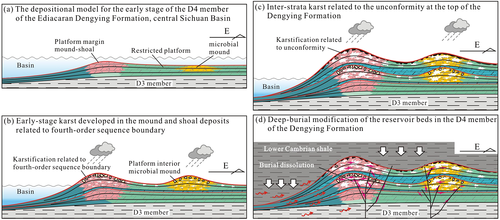
8 CONCLUSIONS
From the observation of cores and thin sections, nine types of lithofacies were identified in the D4 member of the Dengying Formation. Each lithofacies represents a specific depositional environment. Lithofacies associations of platform-margin shoal, mound-shoal complex, intraplatform mound, lagoon, and tidal flat facies were summarized. The platform margin was dominated by shoal and mound-shoal complexes, while the intraplatform contained microbial mound, lagoon, and tidal flat facies.
Based on the comprehensive analysis of cores, seismic and logging data, we identified two third-order sequences (SQ1 and SQ2) in the late Ediacaran Dengying Formation in the central part of the Sichuan Basin. The HST of SQ2 (the D4 member) can be further divided into five fourth-order sequences (SQ2-1 to SQ2-5). The fourth-order sequences in the wells of the intraplatform were composed of both transgressive parts and regressive parts while the fourth-order sequences in the wells from platform margins were dominated by the upper regressive parts. Based on the above information, a high-frequency sequence stratigraphy framework is proposed. The thickness of the mound-shoal complex in the D4 member increases from the lower fourth-order sequence to the upper fourth-order sequence.
Results from the analysed samples show that the reservoirs in the D4 member generally have low porosity and low permeability. The reservoir spaces predominantly include dissolution vugs and caves, as well as intercrystalline vugs and pores. Three types of reservoirs were identified: early-stage karst mound-shoal reservoir (Type-I), late-stage karst superimposed reservoir (Type-II) and other factors impacted reservoir (Type-III).
Mound and shoal facies were the material basis for favourable reservoirs in the D4 member. Syngenetic karstification controlled by the fourth-order sequence boundary was the key factor for the development of Type-I reservoir. The tectonic unconformity that was formed at the end of the Sinian stage dominated the development and distribution of high-quality Type-II reservoirs. Organic acid, hydrothermal fluid and tectonic fracturing processes initially modified the reservoir beds and had different types of influences on the reservoir quality. Based on our data set, we established a model for the depositional evolution and reservoir formation in the D4 member of the Dengying Formation.
ACKNOWLEDGEMENTS
This work was sponsored by the National Natural Science Foundation of China (41372126 and 41502104), National Science and Technology Major Project of China (2016ZX05007-002), Natural Science Foundation Innovation Group Program of Hubei Province (2015CFA024), and the Yangtze Youth Fund (2015cqn30). We would like to thank the Langfang Branch of PetroChina Research Institute of Petroleum Exploration and Development and the Exploration and Development Research Institute of Southwest Oil and Gas Field Company for data support. We are grateful to Ngia Roger Ngong for the correction of the English version of this paper. In addition, the comments and suggestions by the editors and reviewers were greatly appreciated.



